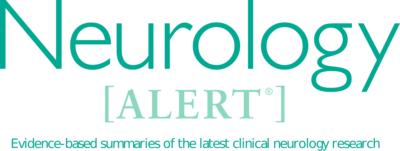
Neurology Alert – May 1, 2004
May 1, 2004
View Archives Issues
-
Clozapine for Dyskinesias in Parkinson’s Disease
Although there are no approved medications to treat levodopa-induced dyskinesias, several strategies are commonly used. Reducing the interval and amount of each dose of levodopa, maximizing the dose of dopamine agonists, and even liquefying the daily levodopa and giving it in small hourly increments are useful in selected patients. The present study evaluates clozapine in a double-blind, placebo-controlled trial as a treatment for levodopa-induced dyskinesias. -
Antibiotics for Alzheimer’s?
Although infectious agents are not widely believed to be the primary cause of Alzheimers disease (AD), some evidence implicates certain neurotrophic viruses and bacteria as possible contributing factors. Canadian investigators Loeb and colleagues suggest that Chlamydia pneumonia infection might play a role in AD. They carried out a randomized, blinded, and placebo-controlled trial testing whether antichlamydial antibiotics (rifampin/doxycycline) could serve as a potential therapy for patients with mild-to-moderate AD. -
A Treatment for Creutzfeldt-Jakob Disease?
This report described the results of a double-blind, placebo-controlled study of flupirtine maleate (FLU), a triaminopyridine compound in patients with Creutzfeldt-Jakob disease (CJD). The patients with flupirtine showed significantly less deterioration in the dementia tests than the patients treated with placebo. -
Ropinirole for Restless Legs
Men and women with restless legs syndrome (RLS), aged 18-79 years, were included in this randomized, 12-week, double-blind, placebo-controlled study conducted at 43 centers in 10 European countries, designed to assess the efficacy of ropinirole, a dopamine agonist, in the treatment of RLS. Ropinirole significantly improved IRLSSG score at 12 weeks compared to placebo, with benefit evident even at week 1. -
Thalidomide Neuropathy
Six patients are the focus of this report defining the neuropathic side effects of thalidomide treatment in multiple myeloma. All patients developed a pure or predominant sensory polyneuropathy while on thalidomide. Thalidomide can induce an axonal sensory neuropathy or, infrequently, a ganglionopathy. -
Magnetoencephalography: Tie-breaker vs Confounding Data for Epilepsy Localization
Non-pharmacologic treatment options for patients of epilepsy include resective epilepsy surgery, vagal nerve stimulation, the ketogenic diet, and experimental protocols. Of these, epilepsy surgery offers the greatest chance of curing the patients epilepsy. To achieve this degree of success, it is critical to localize the epileptogenic zone as accurately as possible. Pataraia et al estimates that MEG provides additional localizing information in 40% of their patients. -
Cerebral Venous Sinus Thrombosis: Favorable Outcome with Heparin Therapy
In contrast to arterial thrombo-embolic ischemic stroke, cerebral venous sinus thrombosis (CVST) is unique in its clinical presentation and treatment algorithm. As reported by Ferro and associates on behalf of the multicenter international ISCVT study, venous stroke, typically treated with heparin, has a good outcome in the vast majority of cases. -
rt-PA Stroke Trials: Pooled Analysis and Opinion
Thrombolysis with intravenous rt-PA (IVrt-PA) is an effective treatment for strokes due to acute cerebral ischemia. This analysis of pooled data confirms that the sooner rt-PA is given to stroke patients, the greater the benefit, especially if started within 90 minutes. The results suggest a potential benefit beyond 3 hours but with a potential for an increased risk of death. -
Correction
-
Clinical Briefs in Primary Care Supplement
-
Pharmacology Watch
